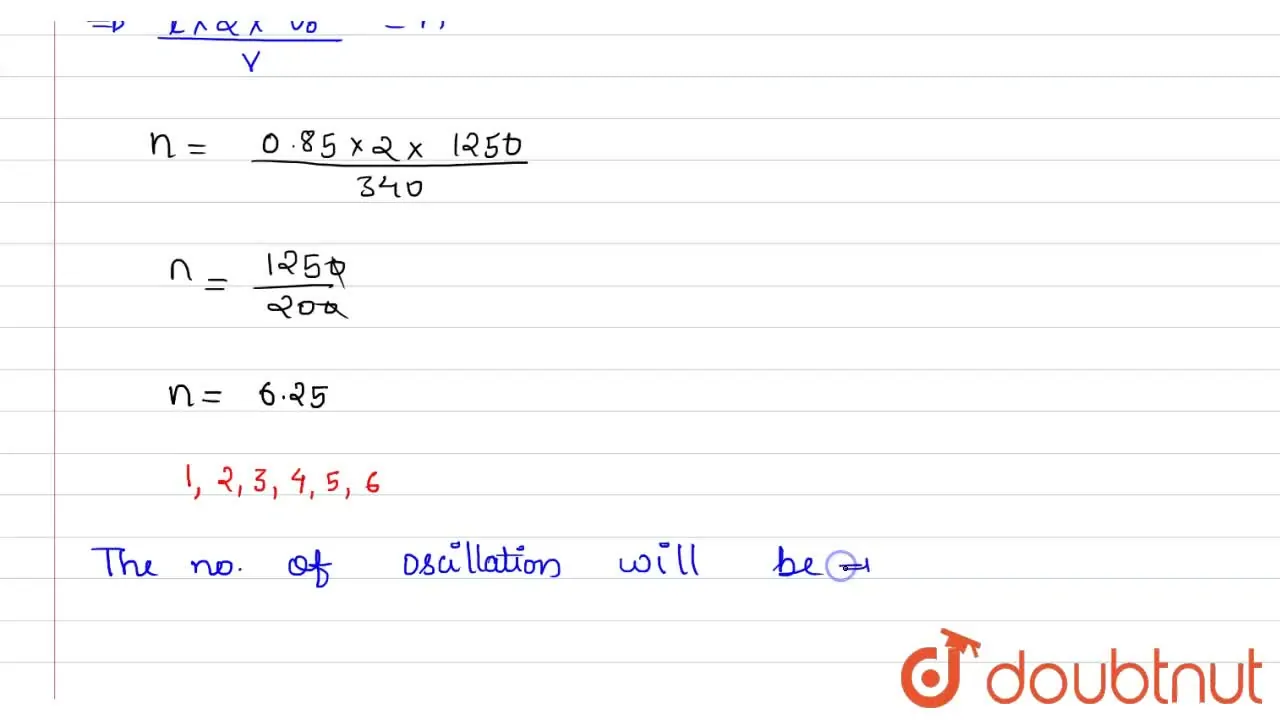Find the number of possible natural oscillations of air column in a pipe frequencies of which lie below v0=1250Hz. The length of the pipe is l=85cm. The velocity of sound is v=340m/s. Consider two cases
i. the pipe is closed from the end ,
ii. the pipe is open from both ends.
First Method
i. Pipe is closed from one end : An air column in a pipe closed from one end oscillates only odd harmonics [ 1st harmonic (fundamental mode ), 3rd harmonic ( 1st overtone ), 5th harmonic ( 2nd overtone ) , 7th harmonic ( 3rd overtone ) etc.]
Fundamental frequency
=v4l=3404×85100=100Hz
Other modes of oscillation are :
3rdharmonic frequency=3×100=300Hz
5thharmonic frequency=5×100=500Hz
7thharmonic frequency=7×100=700Hz
9thharmonic frequency=9×100=900Hz
11thharmonic frequency=11×100=1100Hz
13thharmonic frequency=13×100=1300Hz
Only those natural oscillations are to be counted frequencies of which lie below v0=1250Hz, the harmonics till 11th harmonic are to be counted.
Since number of possible natural oscillations
=1(1stharmonic)+1(3rdharmonic)+1(5thharmonic)+1(7thharmonic)+1(9thharmonic)+1(11thharmonic)=6
second Method
All the frequencies possible are integral multiples of fundamental frequency which is 100Hz. Using the fact that integer which is multiplied by fundamental frequency is the number of harmonic itself you get , highest harmonic predicted =[12.50/100] where [x] represents greatest integer less than or equal to x=[12.5]=12.
Now for closed pipe , only odd harmonics are possible and the highest harmonic possible = 11 th . The possible harmonics are 1,3,5,7,9,11 which are six in number.
ii. Pipe opened from the both ends : Fundamental frequency
=V2l=3402×85×100=200Hz
Frequency of the other natural modes of oscillational are :
2ndharmonic frequency=2×200=400Hz
3rdharmonic frequency=3×200=600Hz
4thharmonic frequency=4×200=800Hz
5thharmonic frequency=5×200=1000Hz
6thharmonic frequency=6×200=1200Hz
7thharmonic frequency=7×200=1400Hz
You have to count only those harmonics whose frequencies are below 1250Hz. All the harmonics till 6 th harmonic are possible , and obviously they are six in number.
Third Method
Fundamental frequency =200Hz
Frequencies possible =n×fundamental frequency
=n×200 [nis1,2,...]
Maximum value of n=[12.50/200]=6([x]represents greater than or equal tox)
Now n is also equal to the number of harmonics for which frequency is being calculated , highest harmonic possible =6th.
As all harmonics are possible in case of open tube , harmonics possible are 1st,2nd,3rd,4th,5thand6th.
Number of harmonics possible in this case =6.
Similar Questions
Find the number of possible natural oscillations of air column in a pipe whose frequencies lie below f0=1250Hz. The length of the pipe is l=85cm. The velocity of sound is v=340m/s. Consider two cases
the pipe is closed from one end .View SolutionA pipe of length 85cm is closed from one end. Find the number of possible natural oscillations of air column in the pipe whose frequencies lie below 1250Hz. The velocity of sound in air is 340m/s.
View SolutionA pipe of length 85cm is closed from one end. Find the number of possible natural oscillations of air column in the pipe whose frequencies lie below 1250Hz. The velocity of sound in air is 340m/s.
View SolutionThe number of possible natural oscillations of air column in a pipe closed at one end of length 85 cm whose frequencies lie below 1250 Hz are (velocity of sound =340ms−1).
View SolutionHow many frequencies below 1kHZ of natural oscillations of air column will be produced if a pipe of length 1m is closed at one end? [ velocity of sound in air is 340m/s]
View SolutionVelocity of sound in air is 320 m/s. For an organ pipe closed at one end of length 2 m the resonating frequency may be
View SolutionThe length of an organ pipe open at both ends is 0.5 m. Calculate the fundamental frequency of the pipe, if the velocity of sound in air be 350 m/s. If one end of the pipe is closed then what will be the fundamental frequency ?
View SolutionA narrow pipe of length 2m is closed at one end. The velocity of sound in air is 320 m/s. Neglecting end corrections , the air column in the pipe will resonate for sound of frequencies :
View SolutionAn open end organ pipe is 0.50 m long. If the velocity of sound is 320ms−1, find the frequency of the fundamental note.
View SolutionTwo successive resonance frequencies in an open organ pipe are 1944 Hz and 2592 Hz. Find the length of the tube. The speed of sound in air is 324ms−1.
View Solution


